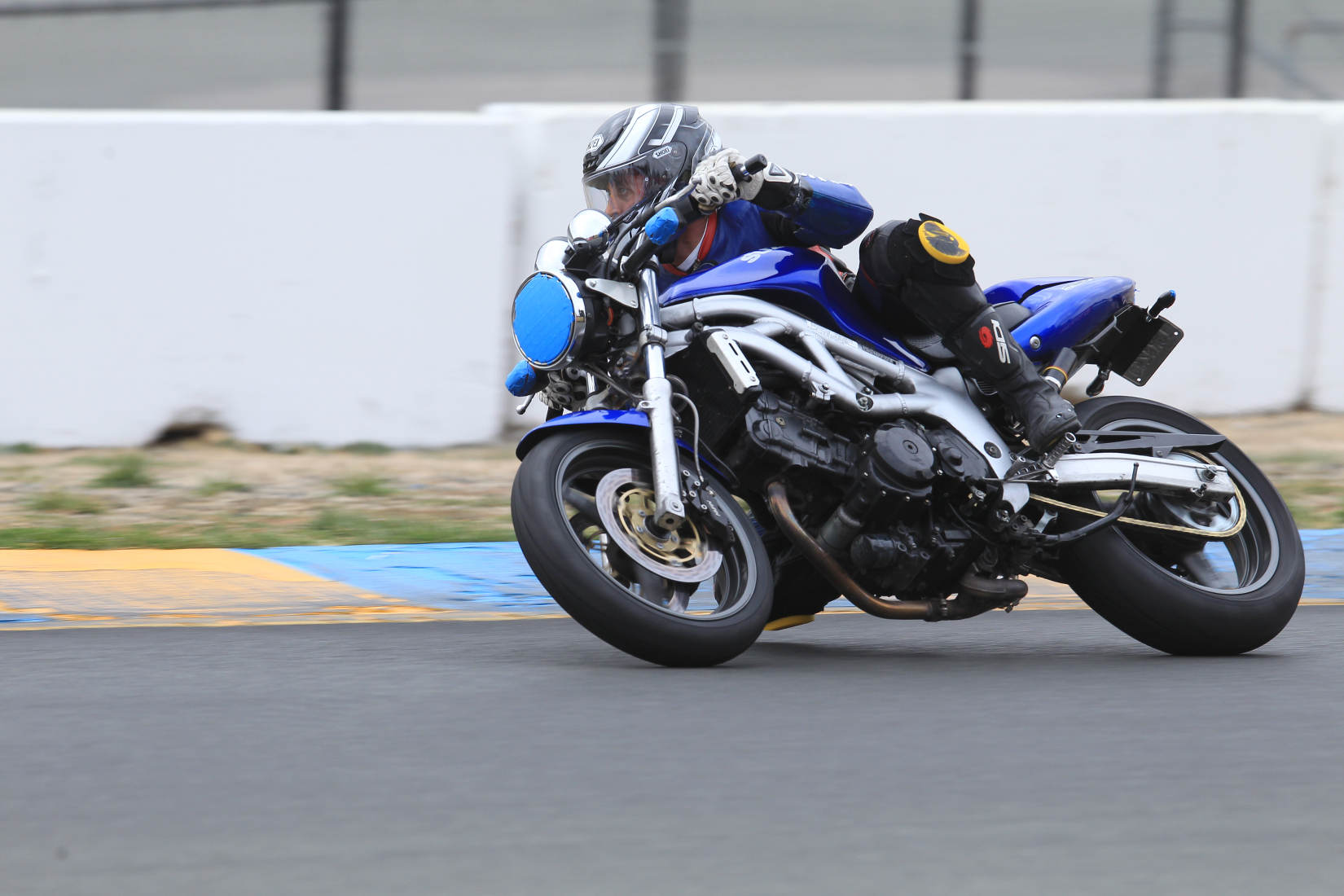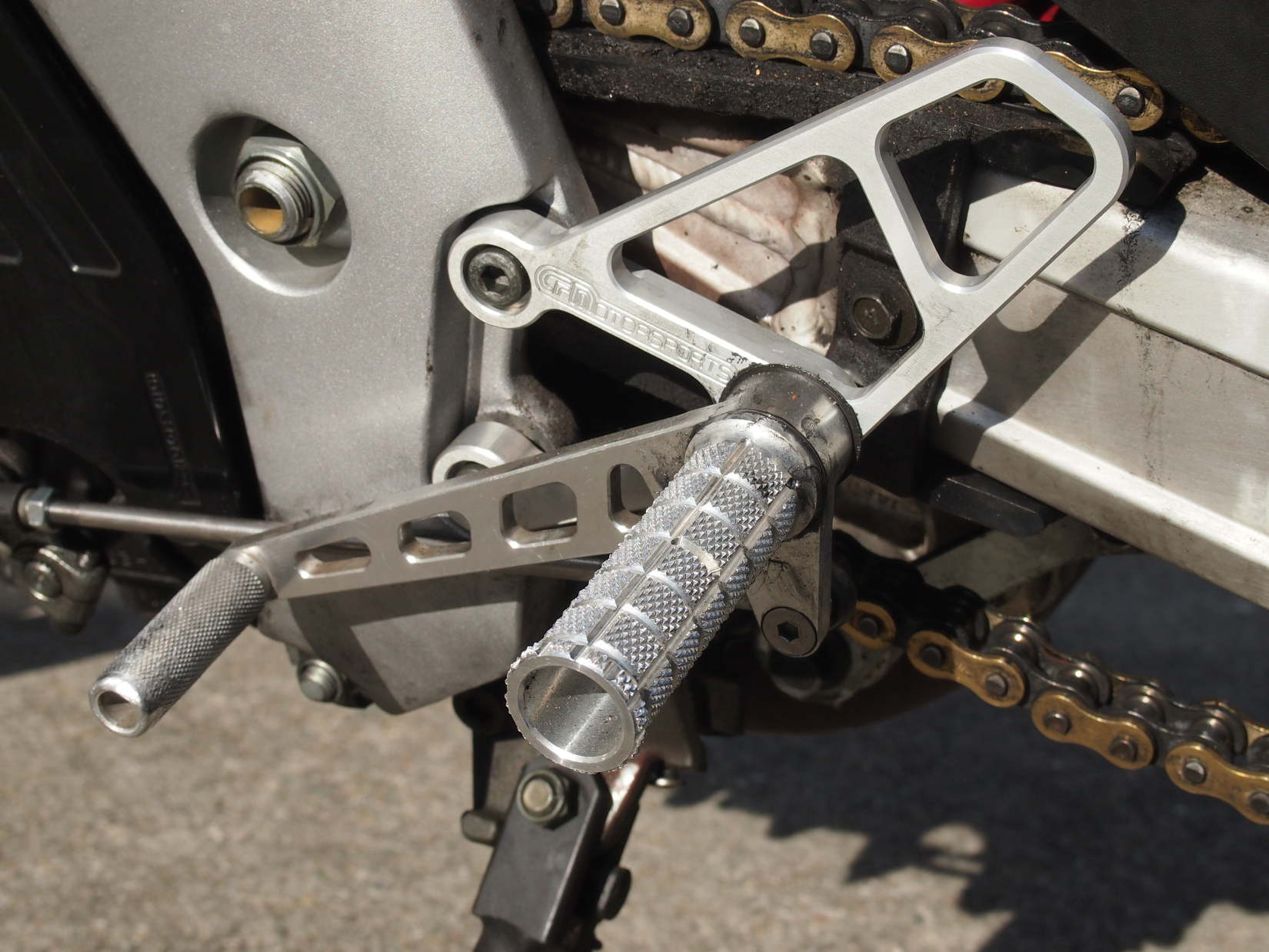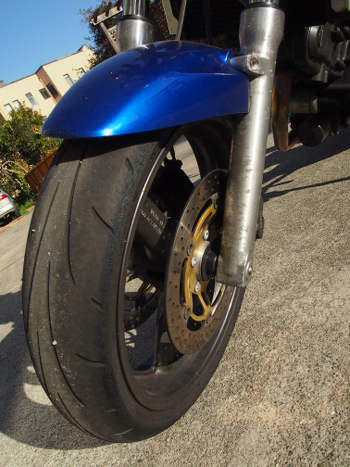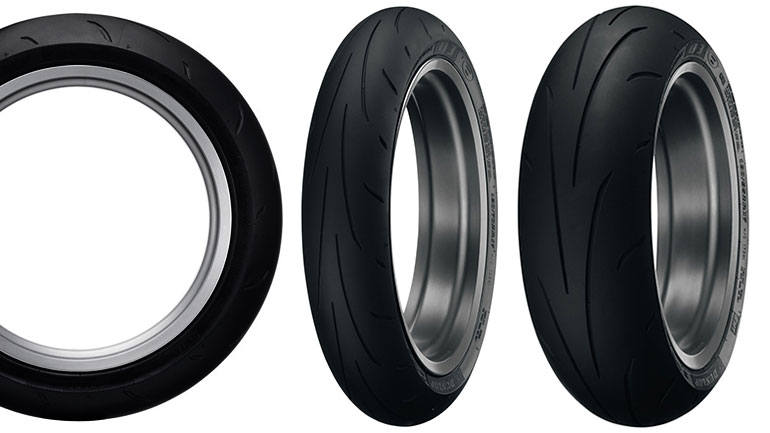If you’ve been following my SV650 project stories (Part 1, Part 2 and Part 3), you’ll know that the SV is motorcycling distilled to its essence. A sweet-handling chassis mated to a flexible motor that provides just the right amount of smooth and manageable power. Sound like just the ticket for an occasional track-day machine? You are right.
If you’re getting on track as an occasional trackday participant (and I recommend that highly, whatever machine you own) you’ll need or want a few key mods on your bike, mods that will make your street riding more fun as well.
First is suspension, and you can refer to my last installment to see what I did for my SV. You can ride around crappy suspension on a street ride, but the high speeds of a racetrack can make that hazardous. At the least, get fresh oil and go to a suspension expert to make sure you have everything adjusted as best you can.
Second would be brake lines and brake pads. This will make you change your brake fluid and get you the braking control and power you may need at elevated racetrack speeds. And while you’re filling your garage up with containers of dirty fluid you’ll probably never take to the recyclers until you move, you might as well swap your coolant for distilled water and additive, if your trackday organizer insists on it. And fer’ gosh sakes how about giving your bike a bath? Some trackday providers will fail your bike at the tech inspection for being dirty, and not because they’re germaphobes — it’s because the grease and grime could be hiding problems like a missing master-link clip on your chain, for instance, or a small fluid leak that could get worse when you pin it to win it.
If you stroll through the pits at a trackday or club roadrace, you’ll notice that most of the heavy users have replaced their stock footpeg brackets with custom “rearsets,” replacement brackets designed to serve a few important purposes. They allow the rider to fine-tune his or her riding position, moving the rider’s feet back and up for better weight distribution, control and cornering clearance. They give the rider the choice of flipping the shift arm upside-down for a one-up, five-down “GP” shift pattern, are much more resistant to crash damage (and cheaper to repair) and act as an extra set of frame sliders if they’re a sturdy design. I also like rearsets because they make handy hardpoints for jackstands so you can remove and replace your rear shock. (Sadly, Bursig stand doesn’t make an adapter for the SV.)
My favorite brand of racing accessories—including clip-on handlebars—is Woodcraft CFM. Woodcraft’s products are strong, simple, affordable, easy to repair and intended for racers. Woodcraft products aren’t mere eye-candy, and that’s why the rearsets for the first-gen SV650 (Woodcraft makes them for the newer SV as well) look so plain-Jane. They’re cut from billet aluminum and multi-configurable. You can order a milder pullback that sets your feet about 1.5 inches higher than stock (.75 inches if you have the SV650S) or the “high” version for the GSX-R750, which puts your toes up and back two inches (1.25 on the S). If you’re budget-minded, you can opt to get just the brackets, pegs and shift-rod ($215) and re-use your stock levers, or get the complete kit ($340), which includes the levers. Bolting it on is easy and takes an hour or so, depending on how bad you are with this kind of thing.
I like my rearsets. The seating position is cramped for long rides, but perfect for the track and the classic look (Woodcraft has been making them since Suzuki introduced the mid-’90s SRAD GSX-R750) works well with my Gen One’s curvy aluminum frame. They are very durable, but if they get damaged, Woodcraft sells replacement parts—no need to replace the whole thing. Adjustability would be nice, but that can come at the price of durability and some riders say adjustable rearsets flex. I don’t know about that, but I do like the solid, locked-in feel I get from my boots. The basis of speed and control on the track is body positioning, and Woodcraft rearsets—in a real sense—form the foundation of a good riding position.
The most important equipment for racetracks are round, black and go on both ends of your bike. When I first started doing trackdays, there weren’t a lot of tire choices for occasional track riders—you could get slicks or (barely) DOT-legal racing tires, which were expensive and only good for a few full days, as they would “heat cycle” and lose their grippiness. Street rubber would overheat on racetracks and make a hot day an exercise in traction control by the last session.
Those days, thankfully, are gone. Now we have a huge selection of sporty rubber that offer the grip of racetrack tires from 10 years ago, but the wet-weather performance and longevity of sport-touring tires from that same era. And they’re incredibly cheap, adjusting for inflation — I would pay $400 for a set of Metzler M-1s 15 years ago, $560 in 2014 dollars. For roughly half that price (MSRP is $370, but there are deals out there), you can mail-order a set of the Dunlop Qualifier Q3. I’ve always liked Dunlop Qualifiers, as they offer a nice, round, consistent profile, which suits my riding style. The Q3 looks a lot like the Q2 it replaces, but it has some subtle differences that make it an even better sport riding/occasional trackday tire. Dunlop claims the longer, deeper grooves disperse water better, the sidewalls are reinforced with carbon fiber to tune cornering performance and feel, and the shape of the rear tire has been changed to speed up steering response. The rubber is dual-compound, harder and longer-wearing in the middle and softer “lateral-grip compound” on the edges.
Now, I’m not a blazing-fast (or any kind of fast) guy on the track, but I can run with the best in the B-group most days, and the Dunlops seem to match my level of skill and bravado. Dunlop’s race-rubber provider was on hand and told me to run about 30 psi front and back (I run 34 and 36 on the street). Steering response was light and predictable, and I never felt anything but stable and confident while the bike was leaned over. Grip was excellent, despite the cold and slippery conditions of a late-November Sonoma Raceway trackday. “Man,” I said in my helmet over and over as I watched one rider after another slide into various impact zones, “why did that guy get on the gas so hard coming out of that turn? This is just supposed to be a friendly trackday, after all.”
After six sessions, the tires felt like they were still new, there were a few less millimeters on my knee sliders, and I had a great time—what more do you want from a trackday tire? Especially tires you only spent less than $300 to buy and mount.
On the street, I’m happy with the Dunlops as well. The ride is smooth and comfortable, even as they wear—and after about 3,000 miles I’m less than halfway through the life of the tire. Consider my favorite rubber when I had my last SV would be pretty much done after 2,500. Wet-weather grip is similar to sport-touring tires. Dirck had a chance to ride my bike with the Q3s and he also liked them — in fact, he kept bringing them up. “Gosh, I really liked those tires,” was his in-depth, Editor-in-Chiefly analysis. He was probably just glad my SV didn’t burst into flames. (That was definitely part of it – ed.)
Once again, the SV showed what an outstanding bargain it still is, 15 years after it was the hottest new thing. But it’s still not perfect—stay tuned for another installment on intake and exhaust.
Racetrack Images Courtesy Mike Doran and Max Klein
Gabe Ets-Hokin is the Editor of CityBike Magazine, and a frequent contributor to MotorcycleDaily.com










We’ve owned a 2000 naked for thirteen years and it’s been a fun bike. It’s been great for commuting, traveling, track days, and second gear wheelies.
If you’re a sportbike rider then it does need some modifications. Our has a Fox Twin Clicker, Race Tech springs and Emulators, full Yosh, Suburban Machinery bars, Toby damper, and a Shorai battery.
I wonder if in the future Motorcycle Daily could do the common cam swap or install cartridge internals in the stock forks. Please.
Hello?
Back in 02-05 I raced with CCS on an EX500 at LRRS. My friend had the SV and we entered that together in the endurance events. The SV had GSXR 750 bodywork on it. Here is a picture of me in Daytona in 03.
re: “The SV had GSXR 750 bodywork on it. Here is a picture of me in Daytona in 03.”
okay, very funny, you got us.
Please Suzuki – bring back the SV650 standard. Update a little if you must, but leave intact the essence of the great ‘all-rounder’. I have been looking in vain for five years for a reasonably priced used one. No luck! Unfortunately the Gladius is over styled, and looks like it might be nipped up for the ladies, even in macho black. No offence ladies, but your tastes are a little different. I might still buy one anyway. That engine alone is worth the price of admission. Anyone have any experience to share regarding the Korean copy of the SV? What little I have heard was not that encouraging, but a good knock-off of the SV650 is well within the capabilities of the amazing Korean manufacturers. (hundai, kia)
Hyosung is known to have been an engine supplier to Suzuki for many years. The bike you’re referencing is nice enough, just not quite as nice as an SV and not supported by the aftermarket and user group that the SV is.
5 years? What price are you considering reasonable? I occasionally see decent 1st gen SV’s for under $2k.
You can learn so much reading MD…
http://www.motorcycledaily.com/2013/08/md-double-take-2013-hyosung-gt650/
It’s actually not too bad. As good as the Gladius, but not as good as an aluminum-framed SV.
Great article – really enjoying this series. Couldn’t agree more about the Dunlops – I got 8 trackdays (!) out of a set of Q2s last season before they really went off, and I was approaching reasonable race pace on them. My bike is a 2006 Ducati Sport Classic, which I will start racing this year (mostly against SVs, in Battle of the Twins Lightweight) after doing 4 years of track days on it. I will run slicks with warmers for competition but honestly, it wouldn’t be totally crazy to attempt it on Q3s.
You are awesome!
With my 1st gen SV track day bike, to save money on the rearsets, I’ve been using adjustable plates from SVRacing.com to give me some flexibility in foot position, at $50-$60 nowadays, they’re an inexpensive alternative to full rearsets. I’m not fast enough to worry about flexing those parts and stock bits can be found on eBay if (heaven forbid)I spend some some closely inspecting the track surface with ma butt.
I bought some Q3’s for this season, so I’m glad to see they worked well!
Yes! Adapter plates like those are a great way to get rearsets for cheap. You don’t get the hard-point you get with racing rearsets or the easy-to-fix footpegs that double as engine guards.